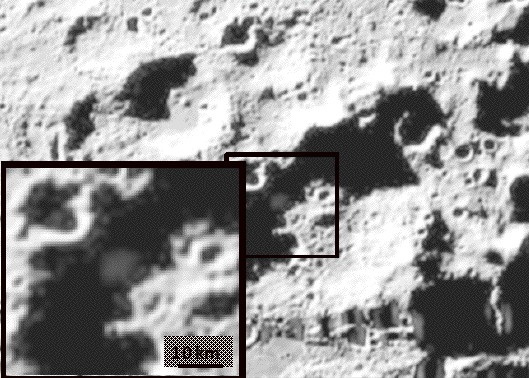NASA issued the following press release about new data that indicates there may be water on the moon. Here’s the full text:
The argument that the moon is a dry, desolate place no longer holds water.
Secrets the moon has been holding, for perhaps billions of years, are now being revealed to the delight of scientists and space enthusiasts alike.
NASA today opened a new chapter in our understanding of the moon. Preliminary data from the Lunar CRater Observation and Sensing Satellite, or LCROSS, indicates that the mission successfully uncovered water during the Oct. 9, 2009 impacts into the permanently shadowed region of Cabeus cater near the moon’s south pole.
The impact created by the LCROSS Centaur upper stage rocket created a two-part plume of material from the bottom of the crater. The first part was a high angle plume of vapor and fine dust and the second a lower angle ejecta curtain of heavier material. This material has not seen sunlight in billions of years.
“We’re unlocking the mysteries of our nearest neighbor and by extension the solar system. It turns out the moon harbors many secrets, and LCROSS has added a new layer to our understanding,” said Michael Wargo, chief lunar scientist at NASA Headquarters in Washington.
Scientists have long speculated about the source of vast quantities of hydrogen that have been observed at the lunar poles. The LCROSS findings are shedding new light on the question of water, which could be more widespread and in greater quantity than previously suspected.
Permanently shadowed regions could hold a key to the history and evolution of the solar system, much as an ice core sample taken on Earth reveals ancient data. In addition, water, and other compounds represent potential resources that could sustain future lunar exploration.
Since the impacts, the LCROSS science team has been working almost nonstop analyzing the huge amount of data the spacecraft collected. The team concentrated on data from the satellite’s spectrometers, which provide the most definitive information about the presence of water. A spectrometer examines light emitted or absorbed by materials that helps identify their composition.
“We are ecstatic,” said Anthony Colaprete, LCROSS project scientist and principal investigator at NASA’s Ames Research Center in Moffett Field, Calif. “Multiple lines of evidence show water was present in both the high angle vapor plume and the ejecta curtain created by the LCROSS Centaur impact. The concentration and distribution of water and other substances requires further analysis, but it is safe to say Cabeus holds water.”
The team took the known near infrared spectral signatures of water and other materials and compared them to the spectra collected by the LCROSS near infrared spectrometer of the impact.
“We were only able to match the spectra from LCROSS data when we inserted the spectra for water,” said Colaprete. “No other reasonable combination of other compounds that we tried matched the observations. The possibility of contamination from the Centaur also was ruled out.”
Additional confirmation came from an emission in the ultraviolet spectrum that was attributed to hydroxyl, one product from the break-up of water by sunlight. When atoms and molecules are excited, they release energy at specific wavelengths that are detected by the spectrometers. A similar process is used in neon signs. When electrified, a specific gas will produce a distinct color. The ultraviolet visible spectrometer detected hydroxyl signatures just after impact that are consistent with a water vapor cloud in sunlight.
Data from the other LCROSS instruments are being analyzed for additional clues about the state and distribution of the material at the impact site. The LCROSS science team along with colleagues are poring over the data to understand the entire impact event, from flash to crater, with the final goal being the understanding of the distribution of materials, and in particular volatiles, within the soil at the impact site.
“The full understanding of the LCROSS data may take some time. The data is that rich,” said Colaprete. “Along with the water in Cabeus, there are hints of other intriguing substances. The permanently shadowed regions of the moon are truly cold traps, collecting and preserving material over billions of years.”
LCROSS was launched June 18, 2009 as a companion mission to the Lunar Reconnaissance Orbiter, or LRO, from NASA’s Kennedy Space Center in Florida. After separating from LRO, the LCROSS spacecraft held onto the spent Centaur upper stage rocket of the launch vehicle, executed a lunar swingby and entered into a series of long looping orbits around the Earth.
After traveling approximately 113 days and nearly 5.6 million miles (9 million km), the Centaur and LCROSS separated on final approach to the moon. Traveling a fast as a speeding bullet, the Centaur impacted the lunar surface shortly after 4:31 a.m. PDT Oct. 9 with LCROSS watching with its onboard instruments. Approximately four minutes of data was collected before the LCROSS itself impacted the lunar surface.
Working closely with scientists from LRO and other observatories that viewed the impact, the LCROSS team is working to understand the full scope of the LCROSS data. LRO continues to make passes over the impact site to give the LCROSS team additional insight into the mechanics of the impact and its resulting craters.
What other secrets will the moon reveal? The analysis continues!









